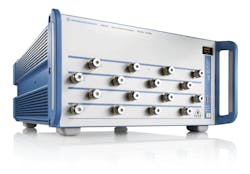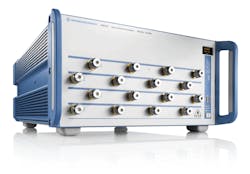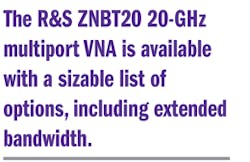Multiport VNA Tests to 20 GHz
This file type includes high resolution graphics and schematics when applicable.
Vector network analyzers (VNAs) are so essential for higher-frequency testing of transmission characteristics that they might be thought of as “microwave voltmeters.” Most commercial VNAs are equipped with two or four ports for measuring the forward and reverse transmission characteristics of RF/microwave devices and components one at a time.
In production testing, however, more ports are needed, and the R&S ZNBT20 VNA from Rohde & Schwarz is designed for that purpose, with 16 integrated test ports and a frequency range of 100 kHz to 20 GHz. Each of the 16 ports provides high performance, allowing for high-volume S-parameter measurements under high-speed production conditions. The multiport analyzer can drive all of its test ports in parallel without compromising performance, for simultaneous testing of multiple devices under test (DUTs).
The R&S ZNBT20 (see figure) provides generous test port power through 20 GHz, with -30 to +6 dBm to 1 MHz, -30 to +8 dBm to 10 MHz, -30 to +10 dBm to 1 GHz, -30 to +8 dBm to 10 GHz, and -30 to +5 dBm to 20 GHz. The source power accuracy is better than 2 dB to 10 GHz and better than 3 dB to 20 GHz, with power resolution of 0.01 dB. The instrument drives all ports in parallel without need for internal switching.
The multiport analyzer tunes frequency with 1-Hz resolution and can perform measurements on as few as 2 and as many as 100,001 points. The measurement bandwidth can be set from 12 Hz to 1 MHz in standard models and from 1 Hz to 10 MHz in instruments with an increased bandwidth option. The typical dynamic range at all ports is high, as good as 115 dB to 1 MHz, 130 dB to 2 GHz, 125 dB to 10 GHz, and 120 dB to 20 GHz.
The measurement accuracy is a function of frequency and test-port power, with amplitude accuracy at the lowest frequencies ranging from 0.30 dB for test-port power of -50 to -60 dBm to 0.06 dB for test port power from -35 to +5 dBm. From 1 MHz to 10 GHz, the amplitude accuracy is 0.10 dB for test port power from -50 to -60 dBm, improving to 0.06 dB for more robust test-port power from -35 to +5 dBm. At the highest test frequencies, from 10 to 20 GHz, the amplitude accuracy is 0.20 dB at the lowest test-port powers, improving to 0.06 dB for test-port power of -50 to -35 dBm and topping out at 0.05 dB for test-port power from -35 to +5 dBm.
Speed is an important parameter for any analyzer in an automatic-test-equipment (ATE) system or meant for production testing, and the R&S ZNBT20 provides the measurement speeds that translate into high throughput testing, with sampling time of a mere 860 ns for a 1 MHz analysis bandwidth and 312 ns for a 10 MHz bandwidth. Measurement speeds and data transfers will depend in part on the choice of communication bus. For example, for a measurement with 201 test points, sweeping a 1-MHz analysis bandwidth from 0.8 to 1.0 GHz, the measurement speed and data transfer will be 4.9 ms over VXI11, 4.5 ms over RSIB, 5.3 ms over IEC/IEEE, and 4.5 ms over USB 3.0. The switching time between channels with a maximum of 2001 measurement points is less than 8 ms, and the multiport analyzer can transfer 201 points of magnitude data via USB 3.0 in 0.5 ms.
The R&S ZNBT20 20-GHz multiport VNA can achieve fast sweep times in support of production testing. Data transfers and measurement times were evaluated with a PC running 64-b copy of the Windows 7 operating system (OS) from Microsoft Corp. For a 900-MHz center frequency, the sweep time is less than 2.5 ms with a full test cycle time of less than 5 ms. For a 5.1-GHz center frequency, the sweep time is less than 2.0 ms and the full cycle time is less than 5 ms. The compact VNA is supplied with 3.5-mm male connectors on its RF/microwave ports and includes two USB 2.0 ports on front panel and two more on the rear panel to help with data transfers.
The analyzer is available with a sizable list of options, including extended bandwidth. An additional option, the R&S ZNBT-K20 option for extended time-domain analysis, makes it possible to perform signal-integrity tests on high-speed transmission standards, allowing displays of plots useful for such analysis, including eye diagrams, rise time, and skew. The R&S ZNBT20 is supported by a number of different ATE test programs, including those from R & S, to speed and simplify setup of production test systems.
Rohde & Schwarz GmbH & Co., P.O. Box 80 14 69, 81614 Munich, Germany; (888) 837-8772
This file type includes high resolution graphics and schematics when applicable.
About the Author
Jack Browne
Technical Contributor
Jack Browne, Technical Contributor, has worked in technical publishing for over 30 years. He managed the content and production of three technical journals while at the American Institute of Physics, including Medical Physics and the Journal of Vacuum Science & Technology. He has been a Publisher and Editor for Penton Media, started the firm’s Wireless Symposium & Exhibition trade show in 1993, and currently serves as Technical Contributor for that company's Microwaves & RF magazine. Browne, who holds a BS in Mathematics from City College of New York and BA degrees in English and Philosophy from Fordham University, is a member of the IEEE.




